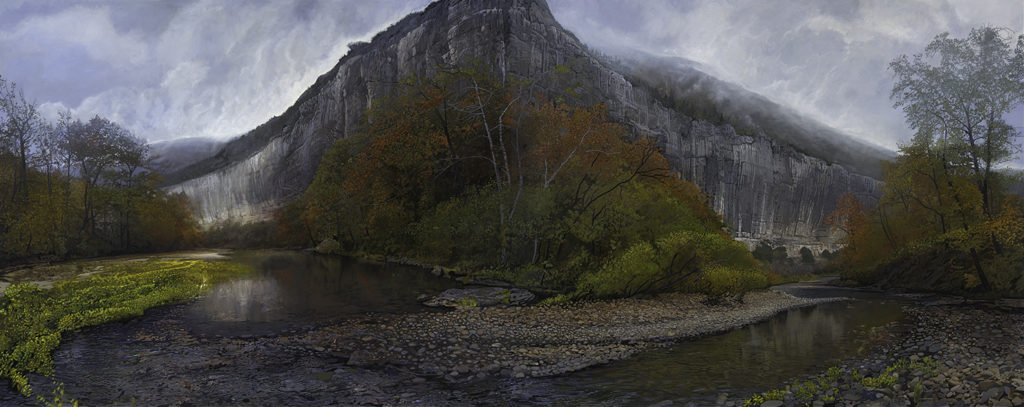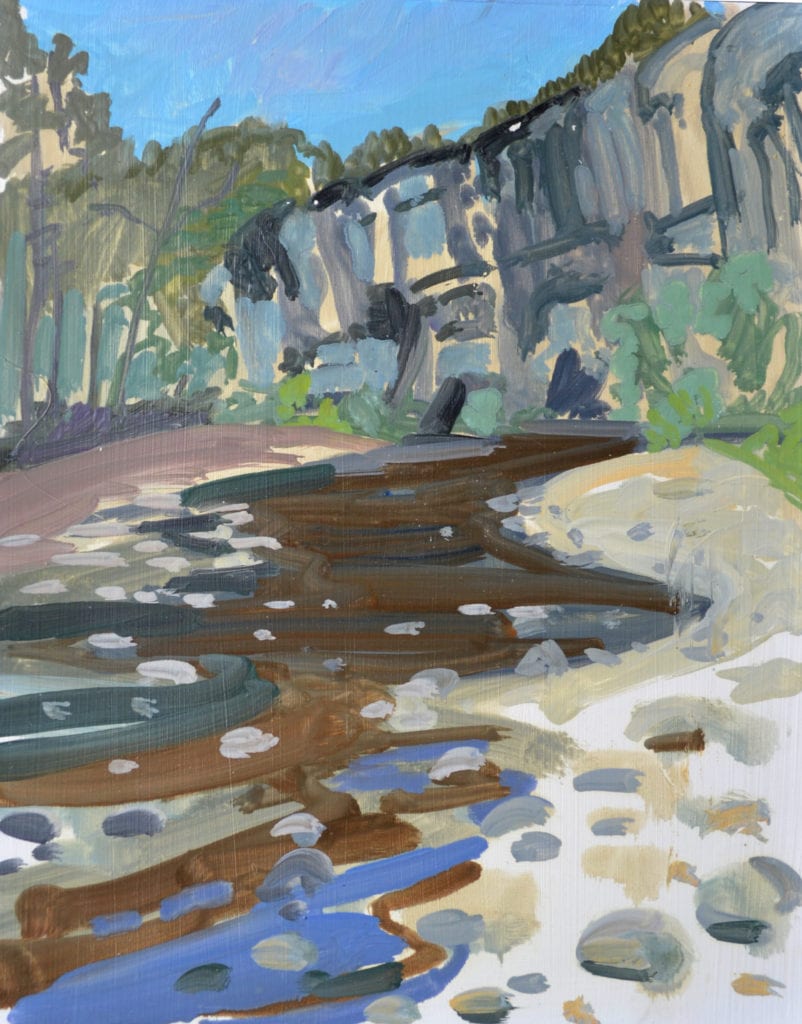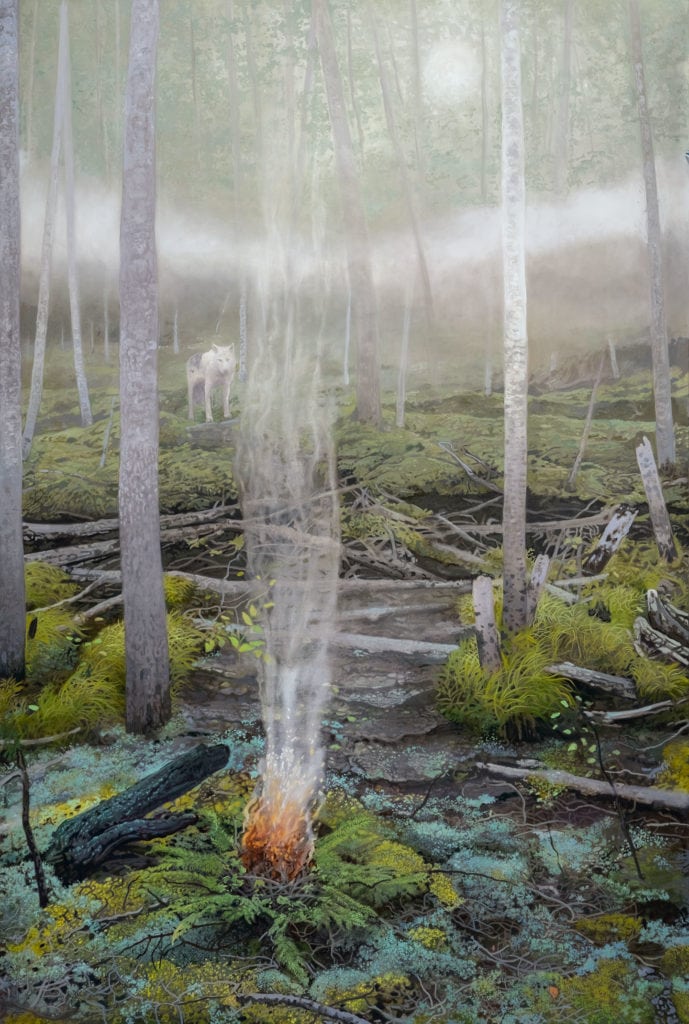Preternatural: Paintings by Michael Scott Cole Carothers
What’s in a number?
We learn to count. But beyond counting begins an associative relationship with this abstract process. There is 1, 2 sides, trinity, 4 corners, five fingers (counting the thumb), 6 swans-a-swimming, seven days to the week, figure eight’s, “number 9… number 9” and then, we add a zero – 10. So on and so on, until we find ourselves trying to fathom infinity, time, space; or what, the unending ratio of Pi? It’s all so irrational.
Let’s go back, to the beginning. Perhaps we might begin with zero. That’s hard to imagine, nothing without something.

So why am I obsessed with numbers when I think about Michael Scott’s exhibition, Preternatural, currently on view at the Cincinnati Museum Center? I suppose it’s got something to do with a unique awareness, an essence as powerful as burning wood, sweet as magnolia, dark as coal, and slippery as ice. Quite possibly, it’s the time he has spent, the brushstrokes he has painted, or the infinite leaves and stones he has seen. As if to quote from Dante
O grace abounding, through which I presumed
to set my eyes on the eternal light,
so long that I spent all my sight on it
In its profundity I saw- ingathered
and bound by love in one single volume
what in the universe seems separate, scattered:
substances, accidents, and dispositions
as if conjoined – in such a way that what
I tell is only rudimentary
Dante, Paradiso, Canto 33 lines 82-90
In all, he presents us with a tour de force, in four parts:
EARTH WATER AIR FIRE
This exhibition is generously conceived and thoughtfully installed. Descending two escalators, as if into a cavern, we enter Preternatural’s ante room with an introduction to America’s natural settings by way of the 19th century. Paintings from the Museum Center’s own collection include Robert Duncanson, William Sonntag and others less well known but equally versed in the vast frontier, debate over Manifest Destiny and expansion westward that inevitably appropriates America’s pristine wilderness.
In the first room of Scott’s paintings, however, it’s apparent this is no ordinary landscape show. The darkly painted walls, dramatically aimed lights, carpeted floors, and soft sounds emanating from Rich Bitting’s soundtrack (composed to accompany the exhibition) envelop and embrace. The effect is like an abbey or sanctuary in which Nature’s drama is rendered vividly in monumental scale. There, to ponder a gift of creation.

Buffalo River Diptych, a place familiar to Scott since childhood, presents an enormous pyramidal stone cliff with an oxbow-like movement to the river below. Compositionally, it conveys symbols of alpha (the stone cliff) and omega (the river). In effect, a beginning and an end. With painterly assertiveness, Scott drags paint in tonal patches before incising shadows with smaller calligraphic brushstrokes to evoke endless crevices that make up the solid stone wall. Below, a fiery cast of autumn leaves rooted to the earth stands aside the river as it meanders around the cliff. Each side of the oxbow, offers a glass-like surface for the cliff to reflect in the river’s stillness, but this is not Narcissus pondering his beauty or youth. The shallows are populated with rich tonal color revealing smooth flat stones tumbled and burnished over millions of years by thrust faults, erosion, and fractures. Pebbles of time as residue second by second.

Wilderness in the American experience has been described as the equivalent to Europe’s cathedrals. It is our place for meditation and worship upon creation and existence. For Scott, and many others, Nature’s wilderness is the profound manifestation of order to life, death, restoration, and mystery. Here, in the interaction between the four elements, Scott treks extensively into our natural wilderness marking time in pursuit of its timeless cycle. There, he paints numerous field studies that probe the essence found in his monumental studio works. His process is a mindful response to natural rhythms, of power, motion, sound, and discovery. In each of the four elements, used as foci for his dialogue and experience, Scott examines their symbiotic relationships to Earth’s endless regeneration.

The fields studies are a shorthand with urgency. Painted on 8×10 sheets of paper easily carried for distances often far greater than the time it takes to paint them, Scott employs expressive gestural marks and broad areas of flat colors that convey important tactile impressions of scale, texture, mass, as well as the time of day, the weather, and a kind of anima mundi. One might consider these also in dialogue with other painters who have focused similarly upon Nature’s mystique. Charles Burchfield and Fairfield Porter come to mind. In the studio, they are important rehearsals for their larger and more finished brethren.

These large paintings, culled from 40+ years of one-on-one interaction, culminate in the last decade with feverish intensity and dedication. There are seminal paintings from the 80’s, 90’s and the first decade since 2000, but the greatest number are from the last 10 years. Forty years is a career, but Nature’s play is timeless and it shows in this exhibition.
Preternatural is open through January 8, 2023
Cincinnati Museum Center